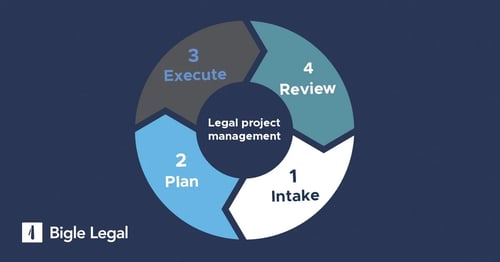Legal Project Management & Better Work-Life-Balance (with Anna Marra)

When you find yourself working 60-hour weeks with a towering pile of casework, it can seem impossible to achieve any form of work-life balance. In fact, a 2017 survey by The Bar Council revealed that half of participating lawyers felt unable to sustain lifestyle equilibrium.
Yet there are many routes towards a better work-life-balance – but could the simplest solution be the way we approach our workloads?
There’s growing evidence to suggest that legal project management (LPM) could be the best way to free up time, resources and expenses!
LPM is the process of applying project management techniques to legal procedures. Under it, departments will plan a project ahead of time, monitor its progress and analyse it once it’s complete.
To better explain the ways LPM can help you achieve a better work-life-balance, we’ve gained expert advice from Anna Marra. For seven years Anna has been the Director of the Legal Project Management Program at IE Law School in Madrid.
She’s also a Co-Director of the Legal Management Program at Thomson Reuters, an Accredited Training Provider and a Councillor on the Advisory Council at the IILPM.
Here, she guides you through the benefits of LPM and explains how applying certain techniques can lead to a better work-life-balance.
Can LPM help balance the lives of lawyers?
The Bar Council recently revealed that 22% its participating lawyers stated they worked over 60 hours a week (up from 13% in 2013), and this number goes up to 27% and 33% for criminal and family barristas, while a 2016 study by MetaJurey proved that attorneys, on average, create and receive more than 70 documents a day. That’s more than 26,000 documents a year!
It sounds simple, but by being as organised and prepared as possible, your daily task list could suddenly become less overwhelming, helping to reduce the amount of time you spend in the office.
It’s suggested that LPM techniques can lead to better project results, allowing you to manage risk, cut legal costs and predict timelines more efficiently, providing your clients with a far better outcome.
Anna explains that by managing your legal projects thoroughly, your department will optimize the allocation and use of resources:
“If we manage to work fewer hours on the same project, we are saving time for our personal lives. Likewise, if we work with control over the cases we manage, we can lower stress levels and improve emotional tranquility.”
In turn, your work schedule will stop looking daunting and you will enjoy an increase in office productivity, happiness and morale.
“If we have the ability to transmit information to the client in anticipation of their needs, we will be able to reduce the external pressure, the non-billable hours and the emotional fatigue we dedicate to resolving misunderstandings and inefficiencies,” Anna says.
She also explains that if we learn to work in teams, clearly defining our roles, duties and the assignment of tasks, we can reduce the internal pressure, allowing everyone to become part of a project, gaining stronger purpose.
“In addition, we are sharing success as failure in such a way that we can detonate the burden of individual responsibility.”
LPM methods to achieving balance and increasing productivity
Being a lawyer in the modern world is far from being easy and relaxing.
According to the World Health Organisation, anxiety and depression cost the global economy US$ 1 trillion per year, due to lost productivity.
According to Carnegie Mellon, it would take around 76 days for lawyers to properly read all the privacy policies they are asked to accept, while IACCM proved that 83% of people are unhappy with the way their firm tackles contracts and admin!
Furthermore, a 2019 report on the State of the Legal Market, by the Center on Ethics and the Legal Profession at Georgetown Law and Thomson Reuters Legal Executive Institute, suggested that firms should question out-dated assumptions and business models, in order to improve morale and speed up admin processes.
Thus, if implementing LPM could increase productivity and help businesses run more efficiently and successfully, it seems an obvious route to change.
There are four stages of LPM:
- The first is setting a project’s goals, allocating resources and timescale and launching it.
- Second, you prepare and launch the project.
- Next comes the monitoring of the project from beginning to end
- Finally, we are assessing the successes and failures, analysing areas for improvement.
As Anna has explained, finding solutions to ease workloads and providing legal teams with a sense of shared purpose, will inevitably boost productivity:
“Legal project management is a tool that provides us with the most appropriate solution and the most suitable resources,” explains Anna. “There are numerous methods and routes to learning LPM strategies, including the Prince2 certification programme and books such as the Project Management Book of Knowledge by Project Management Institute.”
There is a wide array of methods and concepts. applied in project management, including Kanban and Scrum - frameworks designed to help teams apply agile principles and work more effectively together, by managing knowledge and work processes.
There are also the principles of continuous improvement, based on Lean and Six Sigma. Six Sigma is a method of eliminating defects in processes and providing constant improvements of operations within an organization, while Lean is a philosophy aimed at speeding up and improving processes.
Yet Anna believes the best route to using LPM to boost productivity and gain a better work-life-balance, is to use a hybrid of all of these methodologies, selecting methods according to circumstances and adapting to the nature of each project, your environment and your client.
“By choosing any of these paths, you are taking steps towards efficiency, profitability, customer satisfaction and the welfare of lawyers. Each path has its logic and its tools. The starting point is to educate your firm and provide them with a clear business model.”
For Anna, the key is to think things through, be flexible in the face of complex needs, and adapt to your environment.
“In business, success happens when we are clear about our identity and how we can help our clients.”
The role of Legal Project Managers
As well as using useful resources and following proven methodologies, Anna wants us to accept that we can’t always be experts at everything.
If you’re struggling to grasp the concept of LPM, or understand how to implement it in your business, then it may be beneficial to hire a professional to assist you.
“Depending on the size of the office or the in-house legal department, there are different ways to gain support and advice on LPM,” explains Anna.
“Law firms like Seyfarth Shaw and Eversheds, for example, support a team of project managers with different training and certifications, while an independent or small firm will need to take into account the cost of hiring a consultant.”
Weighing up the costs against the rewards can be the key to understanding which path is right for you.
“Hiring a freelance consultant can be a wise decision since they can introduce you to external elements and provide different knowledge and perspectives. A good consultant is not one who has all the answers, but one who asks the right questions and encourages the creation of a framework for a change!”
Anna also suggests that if resources allow, it might be useful to hire a project manager to design a more efficient internal management system, allowing you to select the most appropriate technological solution.
At the same time, it is always idea to provide training for your in-house lawyers to internally implement the company’s chosen path and make sure that everyone is on the same page.
Tools for adapting to Legal Project Management
When it comes to LPM, there are numerous useful resources to help you and your colleagues better adapt to new strategies, but for Anna, one of the simplest routes is completely free and available to everyone:
“If I’m being impartial, I would advise simply to create a profile on LinkedIn and Twitter, where you can follow and interact with Legal Project Management groups. Both these social media sites offer daily articles, podcasts and videos that are helping to define LPM,” Anna says.
As the Global Advisory Counsellor for the International Institute of Legal Project Management, Anna always follows the evolution of this discipline with interest.
“The numerous ideas around LPM have grown spontaneously and are slowly defining the features of this route to legal work.”
As Anna explains, such tools and online communities are key to improving our understanding of LPM, helping us to define what it means and shaping how we work.
“At the IILPM, we have tried to contribute to this evolution, defining a competency framework for Legal Project Managers and creating the LPP (Legal Project Practitioners) and LPA (Legal Project Associate) certifications.”
These are just some of the other fantastic media options available to educate you on the value of LPM:
- The Power of Legal Project Management: A Practical Handbook, by David A. Rueff, Jr. and Susan Raridon Lambreth;
- Legal Project Management: Control Costs, Meet Schedules, Manage Risks and Maintain Sanity, by Steven B. Levy;
- Law Technology Now podcast, by Monica Bay of Law Technology News;
- LPP (Legal Project Practitioners) and LPA (Legal Project Associate) certifications - learn more here;
Major law firm, Clifford Chance, has also launched the first apprenticeship scheme dedicated to training LPM experts, proving that this is the future for legal practices.
The Role of Technology in LPM
As well as online communities and dedicated LPM books and podcasts, there are also fantastic technologies available to legal professionals.
As Anna explains, once you have defined your proposal, designed your strategy, explored tools and management options and adopted a sensitive way of thinking, you can choose technology to support you.
“There’s certainly a sense of urgency in the sector, it takes us away from thinking that technology is not the end, but the means,” Anna says.
The implementation of new tech in your in-house department is an adjustment project, she explains.
“There’s no doubt that technology can create extraordinary value in an intensive structure of human capital. Big data and prediction will also play a fundamental role,” she says.
There are plenty of other fantastic and easy-to-use tools, apps and software out there to aid with implementing and managing legal work.
These include the following:
- Teamwork: enables you to achieve high-performance results with customised task lists and portfolios, tailored to your business needs;
- Redbooth: helps teams manage tasks in a fast and simple manner;
- Monday: allows you to monitor a project’s timeline, plan your strategy, collaborate with colleagues and analyse progress;
- Zoho: allows you to plan, track, and collaborate all in one place;
- Bigle Legal: a document automation platform that enables you to create and manage documents through a user interface.
“For the first time, we have a wide range of technological solutions that we can apply, and each one has a different objective,” says Anna.
“Suggesting a tool is like suggesting a dress: there’s not one that is suitable for everyone! LPM will continue to grow exponentially, so it’s essential that we ask ourselves where we are, where we want to be and how we want to get there.”
Let's get started
Offering the ability to better control your projects, properly planning and tracking every move you make, legal project management could not only lead to lighter work loads, but better outcomes for your clients!.
As Anna points out, the path you choose will differ depending on your company’s ethos and needs, but legal project management could be a fantastic way for you to free up time in order to gain a better work-life balance, allowing you to fall back in love with the law profession!
 By
By



.webp?width=500&height=263&name=3-9%20(1).webp)






